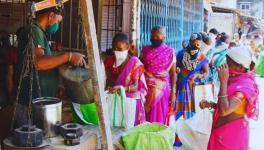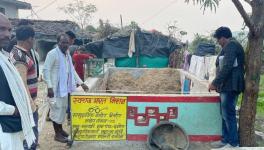COI-19 in Rural India-XXXI: No MGNREGA Work Available Jajpur’s Ampora Village
Image use for Representational only. image Courtesy: NDTV
This is the 31st report in a series that provides glimpses into the impact of COVID-19-related policies on life in rural India. The series, commissioned by the Society for Social and Economic Research, comprises reports by various scholars who have been conducting village studies in different parts of India. The reports have been prepared on the basis of telephonic interviews with key informants in their study villages. This report examines the impact of the nationwide lockdown on Ampora village in Jajpur district, Odisha.
Amporavillage is about 120 km from Bhubaneswar (the state capital) by road and about 20 km from the nearest town, Jajpur-Keonjhar. Information for this report was gathered via telephonic conversations conducted between April 10 and 16, with nine respondents in Ampora and a neighbouring village, Jalasuan Patna.
The population of Ampora is about 1,000, with several different caste groups across about 200 households. Brahmins and kshatriyas make up 10 landowning and farming households each; the 30 vaishya households include those engaged in sweet-making and carpentry; the remaining 150 households belong to the Scheduled Castes and include fishermen, shepherds and others.
About 80% of households in the village are either tenant farmers or casual wage labourers and are economically largely below the poverty line. There are also four individuals in the village who have government jobs and about 10 industrial workers; these villagers travel outside the village for work and the most popular mode of transport used is the motorbike.
The railway station that links the village to the state capital and other big cities is about eight km away, at Tomka. The other major railway station that links the village to other states is at Jajpur-Keonjhar. Only one bus service to Bhubaneswar passes through the village; this is now suspended. There are no otherforms of transport available, and the villagers largely rely on motorbikes and bicycles to commute to places nearby.
Agriculture in Ampora
The village is watered by two small streams to the north and the south. Riverside land is used to grow vegetables, groundnut, and pulses as irrigation water from the streams is available until midsummer.
Agriculture on this land is mainly done by tenant farmers in Ampora—with the exception of seven or eight households who own land along the riverside, the land along the river is mostly owned by people from the neighbouring village of Jalasuan Patna.
Most farmers cultivate paddy in the kharif season. Rabi cultivation takes place only when the monsoon is good. This year a large area of land was sown with pulse crops (moong, arhar and urad) in the rabi season because the monsoon was good. Households also grow vegetables on their land, and five to six households cultivate vegetables along the riverside. The harvesting of pulses began in the second week of April and will continue till April 25.
Some farmers in Ampora own livestock such as cows and goats. Dairy farming and animal grazing have been allowed to continue without much hindrance during the lockdown.
Access to Markets
There are about five or six weekly markets near the village. Due to the lockdown, all these are closed. This has limited the marketing options available to vegetable cultivators, which has forced them to sell their produce for very cheap within Ampora or in neighbouring villages. When the weekly markets were still open, some growers of pulses sold their harvests there, as the prices were better than those available within the village. Since the lockdown has been imposed, the only option left is to sell the pulses to a trader from a neighbouring village at a lower price.
Access to Non-Farm Employment
There are two small-scale food processing units in the area: one that produces namkeen (savoury snacks) and a second that produces murmura (rice flakes). These units have been permitted to continue operating and the police have been allowing the passage of vehicles transporting food and grocery items.
The products from these food processing units are sold in about 500 grocery shops within a 15 km-radius of Ampora. Demand for the products made by both units has reportedly increased during the lockdown, but they are facing a shortage of workers. For instance, Bhibi, the owner of the namkeen factory, used to employ 14 workers, including six male namkeen makers (mistris) and nine female workers engaged in packaging. Since the lockdown, workers have been unable to commute to the unit, so the workforce has reduced to five workers supplemented by two members of the owner’s family.
The murmura unit currently has about four workers, including two members of the owner’s family. Social distancing regulations imposed by the authorities during the lockdown also require the units to have a smaller number of people on the premises.
There are no other non-farm employment opportunities in the village. A few workers who had migrated for work to the nearby industrial city of Kalinga Nagar, returned to the village during the first phase of the lockdown. Also, there is no MGNREGA (the rural job guarantee scheme) work available in the village. Only a limited number of casual agricultural labourers and shepherds are currently working outdoors and in the fields.
Access to Banks, Essential Commodities
The nearest ATM is five km away at Tolkani and Deogan, and there is no bank branch in the village. Many villagers do not have bank accounts. Individuals who are eligible to receive old age pensions or other benefit payments are given these in cash by the Village Welfare Officer (VWO).
The only shops open in the village are grocery stores, and they are the only source of basic food items. Food commodities such as cereals, pulses, potato, onion, milk and vegetables are still available as of now. Families that fall into the Below Poverty Line (BPL) category received their entitlements of rice and other items directly from the Village Welfare Officer (VWO) for three months in advance. However, some poor families who are not in the BPL category have not received any benefits.
Healthcare Access and COVID-19 Awareness
The villagers are largely following social distancing guidelines—some occasionally get together for a game of cards or other games, but they hide themselves when they see the police approaching. At the time when the interviews for this report were conducted, there were no NGOs or civil society organisations actively working in the area to spread awareness.
The closest hospital is located in Gobardhanpur, which is about five km away. This hospital has one doctor, one compounder, four support staff and two ambulances. Until very recently, there was no regular doctor at the hospital; both the doctor and one ambulance have been assigned to the hospital in response to fears over the pandemic. The government has instructed people to inform the hospital if they need medical assistance, and that the doctor will then make a home visit.
The writer is a researcher with School of Inter-Disciplinary and Trans-Disciplinary Studies, IGNOU, Delhi.
Get the latest reports & analysis with people's perspective on Protests, movements & deep analytical videos, discussions of the current affairs in your Telegram app. Subscribe to NewsClick's Telegram channel & get Real-Time updates on stories, as they get published on our website.
























